Jump Ahead To:
ELECTRIC KAYAK: INTRO
Whether you are new to kayak fishing or have many years of experience under your belt, you are sure to know that the traditional way of powering a kayak is by using kayak paddles. In recent years, some kayak fisherman have begun using pedal powered kayaks as well. But did you know that there is a new kind of fishing kayak on the market? Well, there is! It is the Electric Kayak!
This KFC article is dedicated to learning about it! Before you dig into this article, we suggest that you take a look at our Kayak Trolling Motor Ultimate Guide so that you can further your understanding of trolling motors in general. We have even ranked The 5 Best Kayak Trolling Motors! After that, you’re ready to learn about the electric kayak to see if its right for you!
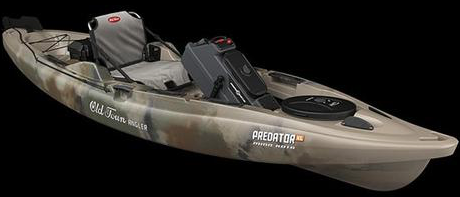
Electric Kayak: Guide

First, as an Amazon Associate, I earn from qualifying purchases.
This article will serve as an all encompassing free resource to teach you about the electric kayak. We have included all of the important details about the electric kayak and decided to do so after a number of KFC readers wrote in to us requesting that we write such an article. To make sure this post is easy to follow and beneficial to you, the kayak fishing enthusiast, we have broken it down into a number of separate categories.
We begin by going over some of the basic information about the electric kayak – What is it? What is it used for? How is it powered? Will it work in the ocean? After you’ve brushed up on the basics, we have included a short section that will show you exactly how to install and use an electric kayak. This is presented in an easy to follow checklist so that it can be quickly referenced in times of need.

After that, we have highlighted a handful of the most important features that you’ll want to be sure to find in your electric kayak. You’ll learn that many electric kayaks have one or two of the features, but it is the combination of these critical features that truly separates the best electric kayaks from the rest of the pack.
We have also included a link to a couple of our favorite types of electric kayaks (first to a trolling motor and second to a package deal) so that you can go straight to the source to read more about their specifications! Then, we have included a short story that details some of our own experiences when using our own electric kayak. It is our hope that you can learn from our knowledge and avoid some of the mistakes that we made! Ok, let’s get after it!
The Basics of an Electric Kayak
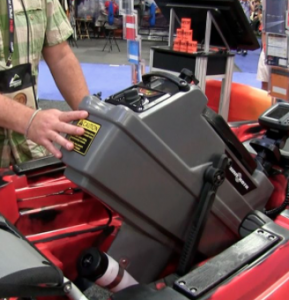
Please note: This post contains affiliate links. An affiliate link means that we may earn advertising/referral fees if you make a purchase through our links.
Shortcut to the Electric Kayak Review
When you hear someone refer to an “Electric Kayak” they will most commonly be referring to one of two things. The first is a fishing kayak that has been outfitted with a kayak motor (sometimes referred to as a trolling motor).
The second would be a kayak that has come as a “package deal” meaning that a motor console (just like you see in the image above) has already been built into the fishing kayak. Both types of electric kayaks are very normal and each certainly has its own distinct advantages when compared to the other.

Electric kayaks typically come with a motor that can deliver between 25 and 55 pounds of thrust. The weight of the trolling motor or motor console will typically be between 25 and 35 pounds. While not a tremendous downside, the typical mounting location for a trolling motor is along one of the sides of the kayak’s hull (usually nearby the fisherman’s dominant arm).
This can, but does not necessarily always, result in a slight leaning of the kayak to one side. This leaning is NOT a problem with the motor console “package deal” kayaks, as the motor is located right in the middle of the kayak – perfectly balanced.

Electric kayaks are typically powered by battery and can have lifespans that allow for an entire day on the water. While not all electric kayaks are built for the ocean, some can manage the saltwater without a problem – just be sure to check with the manufacturer to determine whether the electric kayak you are evaluating is “fresh water only”.
Finally, electric kayaks are designed to be “run quiet”, making them much quite than their gas powered cousins! This ensures that the serenity of kayak fishing is not disrupted by their noise!
How to Use an Electric Kayak Properly

What good is buying an electric kayak if you don’t know how to use it? Even buying the latest and greatest trolling motor or most advanced “package deal” electric kayak isn’t going to make you a better kayak fisherman if you don’t know how to properly install and use it!

We have written the short checklist below to get you up and running with your electric kayak in short order. Remember, if you have any questions about our “Do” and “Don’t” pointers, be sure to comment near the bottom of this page so that we can help you out!
- DO – Make sure to buy an appropriately sized motor. You do NOT need more than 40 pounds of thrust for your kayak motor (unless, perhaps, you are in a tandem fishing kayak).
- DO – If buying a trolling motor, you will likely need a kayak motor mount for purposes of actually connecting the trolling motor to the hull of the kayak.
- DO – Make sure to store your electric kayak or trolling motor in a cool, dry place, away from direct sunlight. Extreme heat and cold, not to mention direct sunlight, will wear on the electric kayak, resulting in decreased longevity!
- DON’T – Do not head out onto the water until you have mastered the concept of directional control with your kayak’s ruddering system. Remember, many electric kayaks will be able to deliver forward and backward motion. Oh, and don’t forget, you need to push the rudder to the left to navigate the kayak to the right!
- DON’T – Do not subject your “fresh water” kayak to salt water conditions. If you are going to be using your electric kayak in the ocean or sea, you’ll want to buy a model that has been conditioned to perform in the salt water. Otherwise, you risk damage to (or even destruction of) the kayak motor, an expensive mistake!
- DON’T – Do not buy an electric kayak or trolling motor that is made of low quality material. We always suggest that your unit be made of composite material (great for flexibility) or metal. Kayak motors and propellers will hit debris (or even the ground) when being subjected to the rigors of kayak fishing. Make sure that your unit can withstand a little punishment and that it won’t leave you stranded away from shore!
Important Features to Find
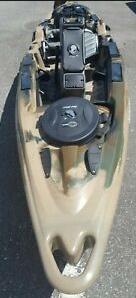
In the last several years, more and more manufacturers have begun to roll out their own models of electric kayaks. This is great for consumers because the increase in supply brings down the cost of what can otherwise be a pretty pricey product. But the increase in supply doesn’t mean that all of the new electric kayaks and trolling motors are of acceptable quality.

Yes, many are perfectly adequate for kayak fishing purposes, but we are looking for the best of the best. When you are deciding on what electric kayak you want to move forward with, make sure you consider whether it has each of the features below, they are absolutely critical!
- Rudder Steering; Foot Controls. One of the perks of buying an electric kayak is that you are able to free your hands to take care of other business (like working your fishing net or baiting your hook). You’ll want to find an electric kayak that is integrated with a foot controlled steering and rudder system!
- Pedal controls are located near the kayak fisherman’s feet. It is far easier to navigate with your feet and let your kayak motor do the “pushing” for you. We have included an example of a foot pedal rudder system below:
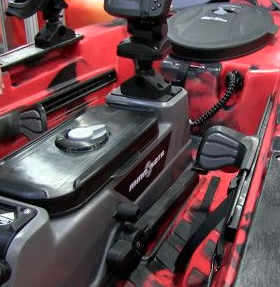
- Motor Console. The motor console is perhaps the distinguishing feature of an electric kayak. Make sure that your model provides for a “drop in” motor console (don’t worry – the motor console comes with the kayak). The bottom of the kayak’s hull is manufactured with a carveout into which the motor console is lowered.
- Once properly lowered, the kayak is again water tight. We like the built in motor consoles (as opposed to buying a transom mounted trolling motor) because, even though not significant, we have noticed that our kayak can “lean” to the side upon which the trolling motor has been mounted. The electric kayak’s centralized motor console avoids this problem!
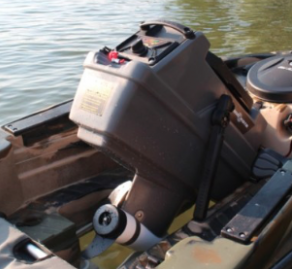
- Appropriate Motor Size. Earlier we mentioned that kayak motors usually range from being able to provide 25 to 55 pounds of thrust. We always suggest that you get an electric kayak where the motor can deliver at least 40 pounds. Why?
- Oftentimes you will be using your kayak motor to battle strong currents or winds, and the extra poundage of thrust certainly comes in handy when you are facing the counteracting force. Also, its never a bad thing to be just a bit faster than some of the others on the water – you’ll win the race to the best fishing location!
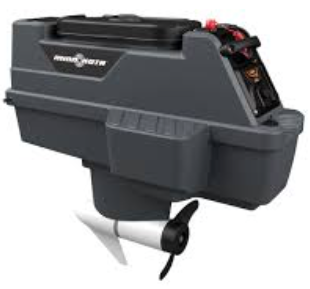
You should also check to make sure that the kayak motor is enclosed in a protective casing. The casing is the piece of metal or plastic that protects the inner workings of the motor. If you have a weak casing, or no casing at all, your motor will become damaged and you will be looking at an expensive repair.
Also, you’ll want a two or three prong propeller. Any additional prongs are counter productive for your purposes. Be sure that the propeller is built of reinforced plastic or metal – otherwise you run the risk of chipping or snapping, resulting vibrations to the kayak or even an outright inability to steer whatsoever!
Buy the Best Electric Kayak

You can take a couple of different paths when seeking to acquire an electric kayak. Remember that you can buy a trolling motor (like the one shown below) that can be attached to the side of your existing kayak (with aid of a mounting plate). This is a great option for those of you who already have a kayak and don’t want to buy a “package deal”.
(Commissions Earned)
The above pictured trolling motor has an ergonomically designed 6″ wide throttle grip and delivers 55 pounds of thrust! It is available in shaft lengths from 36″ and 42″.
Weighing only 25 – 30 pounds, this model is easy to install and won’t cause a severe leaning of your kayak. The shaft is built of composite, rather than metal, material – perfect for the rigors of kayak fishing (more flexible than metal)! Be careful, this trolling motor is “fresh water only” – those of you who tend to kayak fish in the ocean will need to look for an alternative that has been designed for encounters with salt water!
(Commissions Earned)
This model of electric kayak is just over 13 feet long, 36 inches wide, and weighs 117 pounds. It can support a load of 600 pounds and the included trolling motor delivers 45 pounds of thrust!
It comes with a salt water grade motor (can be used in the ocean), with six quality mounting plates (where other kayak fishing accessories can be attached with ease). Also, it features a hands free, foot directed ruddering system, and can even power forward and reverse! For those tech junkies out there, it includes USB charging ports. Certainly a desirable package deal!
My Experience
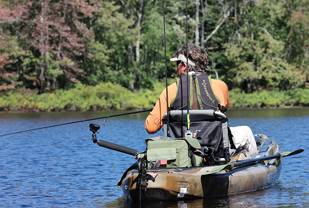
It took some persuading to talk me into using any kind of motorized kayak while out on the water. I always thought that kayaks and kayak paddles went hand in hand in terms of kayak fishing. I never put much thought into doing it any other way.
Sure, I knew that some people had positive experiences using foot pedal kayaks, and that’s fine, but it was’t for me. Plus, wouldn’t adding a motor to a kayak be disruptive in terms of engine noise? I was wrong.

An electric kayak has been one of my all time favorite purchases in terms of kayak fishing gear. First of all, using an electric kayak is FAR easier in terms of moving the kayak from location to location. Necessarily, the quicker you can move from spot to spot, the more locations you can fish. More locations oftentimes means greater results!
It is worth noting that the noise from my electric kayak, while present, was nothing like what I had feared. For some reason I just assumed that the kayak motors would be loud like their gas powered cousins. Luckily, the motors have been designed to “run quiet” and they certainly don’t seem to bother the fish!
ELECTRIC KAYAK: CONCLUSION

I hope this article has served as an informative source of information about the electric kayak. These types of fishing kayaks are relatively new to the scene, but that should not deter you from putting serious consideration into buying one for yourself. I have used both the “total package” electric kayak (I am a fan of the centralized motor console) and the kayak trolling motor. Each are great for different purposes and I find that I use one of them more often that I use my old kayak paddles!
If you have made it to this point and find that you still have questions about electric kayaks, we would suggest that you please comment in the Comments board of this article! Thousands of fellow kayak fishing enthusiasts visit this site every day and many would be capable of responding to your questions about the electric kayak and whether it is right for you! Interested in learning more about this manufacturer? Click here!
If you want to take your kayak fishing to the next level, consider entering a kayak fishing tournament!
Comments
What is your impression of the electric kayak? Do you traditionally use kayak paddles but now you are ready to branch out? Does the “total package” or the trolling motor look more appealing to you? Are you concerned about engine noise or whether you’d be able to keep up with the maintenance of this type of equipment? Please make sure to comment by posting below. We love hearing from the kayak fishing community! Good luck out there!




Wow! I never knew there was so much to learn about electric kayaks! Thanks for the tips and info!
Do these hold up well in choppy or wavy conditions?